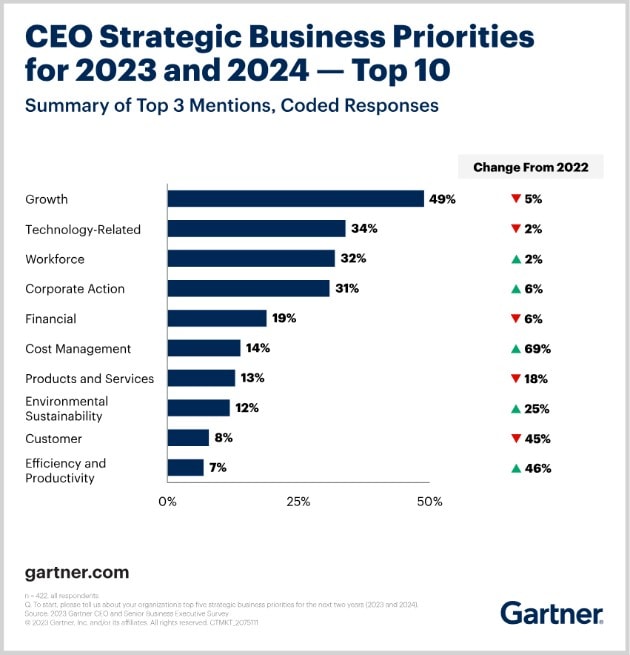Top 5 2024 Customer Experience Trends and How to Leverage Them

This isn’t going to be your typical 2024 customer experience trends roundup. Trends are great to be aware of, but they usually don’t have a lot of staying power. What does have staying power is your overall CX strategy, which not only dictates which trends you should leverage, but also why and how.
That said, we are going to tell you our top 5 CX trends. But we’re also going to tell you the strategic moves you can make in 2024 to set you up for lasting success long after the trends have gone away.
The 5 Trends:
1. Deprioritizing the Customer: What is Going On?!
First, let’s talk about the one big, elephant trend in the room: CEOs are deprioritizing the customer experience going into 2024.
It isn’t exactly surprising; economic pressures have been building over the last few years and 2023 was characterized by a barrage of “will they, won’t they” recessionary headlines that seem to be making another appearance as we break the surface of 2024.
But there’s more to it. Gartner reported in their annual CEO Survey that, of the top 10 business priorities for CEOs in 2023 and 2024, “the customer” came second to last. What’s interesting, however, is that while the customer came nearly dead last as a priority, “growth” took the number one spot.
That begs the question…

How can sustainable, profitable growth be achieved without loyal, engaged customers?
We’d venture that perhaps today’s CEOs, succumbing to economic pressures, are doing what they need to right now to see any upward movement in their bottom-line numbers. But what, exactly, is the cost of deprioritizing your customers in favor of shorter-term wins?
Because we don’t do business in a vacuum, consumers have noticed that many brands aren’t delivering on their promises lately. In fact, 37% of people worldwide think that many companies are prioritizing higher profits over better customer experiences. And now, they’re taking action.
CEOs are deprioritizing the customer experience in 2024.

Amazon Prime Video recently presented a cautionary example of deprioritizing the customer experience in favor of profits after announcing that they would start running streaming ads for Prime members (who have enjoyed an ad-free experience included with their membership up to this point).
Amazon faced instant, scathing media coverage and backlash from outraged customers threatening to cancel their Prime memberships. And they likely won’t be the last company to get publicly called out as CEOs grapple to balance CX with slimmed down profit margins in 2024.
So, while it may be “trendy” to deprioritize CX right now, it’s important to remember that while customer experience trends are not necessarily constant, people are. And if you deprioritize the people giving you their business, they may simply take their business elsewhere – permanently.
2. AI Adoption: Keep it Customer Centric
Many companies are hoping to cut costs with better customer service chatbots, understand experiences using synthetic customer data, and increase loyalty by using AI tools to simulate empathetic interactions with customers in 2024. And although some combination of necessity and FOMO has everyone clamoring to leverage AI more, somewhere in all the hype surrounding this landmark tech evolution are two prevailing themes that cannot be ignored by CX leaders:
2. Consumers have an increasing fear of losing human connection due to AI and technology, and are demanding more human-driven, empathetic interactions with brands.
Before following suit with the masses, ensure you’ve done the customer experience research to support and inform such AI and tech adoptions. Generally, that begins with tuning into your VoC data and asking how specific AI adoption will enable better customer connections, or what customer-reported pain points in their journey it could help solve.
Gartner predicts that by 2026, 75% of customer service calls will be from individuals seeking human interaction due to loneliness.
Even though we in the business world are understandably all over the AI (r)evolution, it can’t be ignored that almost half of consumers still report skepticism and discomfort around engaging with AI-powered support. Therefore, it’s a critical business move to first find out where your customer sentiments lie before widely adopting, for example, AI-powered customer service channels.
3. Acquisition Obsession: Grow Through Existing Customers Instead
McKinsey has a point. The benefits of shifting strategic focus away from aggressive acquisition tactics in favor of (customer) experience-led retention and growth strategies in 2024 are clear.
Successful experience-led growth strategies have tangible financial benefits:
Source: McKinsey
5-10%
more share of wallet
15-25%
increase in cross-sell rates
20-30%
improvement in customer satisfaction & engagement rates
For one, companies are racing to one-up each other in over-saturated markets during a time when brand switching is easier than ever. More than that, there is a constant stream of disruptors and new digital solutions entering all brand categories, making us feel one step behind.
Fortunately, it’s much more sustainable to grow through expanding business with your existing, already loyal, customers. In fact, 80% of the value creation achieved by the world’s most successful growth companies comes from their core business – mostly through unlocking new revenues from existing customers.
Prioritizing experience-led growth and retention is also a much more customer centric business strategy, as it fosters more customer loyalty, advocacy, and ultimately expansion – without needing breakneck acquisition targets.
4. Overcomplicated Customer Service: Fast, Friendly, & Easy is Better
1. Differentiation is more challenging with saturated markets and regular disruption.
2. Empathetic customer service interactions are becoming a rarity in the era of tech, AI, and customer service staffing struggles.
3. The speed of ecommerce experiences is continuing to shape customer perceptions and expectations across ALL brands they engage with.
If you can’t afford to lower prices to keep customers in 2024, your CX can have a huge impact on your bottom line because customers are willing to pay more for fast, friendly, and easy experiences.
“Speed equals caring.”
~Jay Behr, CX Expert & Keynote Speaker,
Let’s start with the “fast” and the “friendly.” These qualities tend to overlap in the minds of customers. For example, customer experience expert Jay Behr says in his Consumer Patience Study, “Speed equals caring. Most customers believe that if it takes somebody a while to get back to you before they have your money, they might take longer once they have your money. If you’re not consistently the first to respond to customers, it doesn’t matter how good you are or how much you charge, you are losing business.”
According to Behr, speed is the number one most important component of customer experience overall.
Although speed can be a differentiator on its own, speed without empathy can come off as transactional at best and frustratingly ineffective at worst. However, when a friendly, empathetic human is behind the fast service, it’s more meaningful because there’s also that connection and community consumers want now more than ever.
And if the service experience is easy and convenient on top of that? That’s the gold standard.
Overall, customers want you to meet them where they are, connect and empathize with them, and provide a quick and ideally convenient path to resolution – sometimes it really is that simple.
5. Employee Engagement vs. Customer Focus: It’s Not One or The Other
After the last few years of labor shortages, budget cuts, and work from home strife, EX (and productivity) has taken a hit. According to Gallup, “In 2024, employers and employees are heading for a relationship reset. But one particularly concerning trend is the decrease in employees who feel connected to their organization’s mission and purpose.”
However, the smartest, savviest companies will embrace both EX and CX. We call this making the CX and EX connection and it can help you drive revenue forward in 2024 in bigger ways.
These companies, like their customer obsessed competitors, will make CX a C-level strategic priority, with CX leaders educating and aligning peers around customer obsession and rallying employees in all departments around customer experience goals.
When you demonstrate (and communicate) a commitment to getting employee buy-in when it comes to the customer, it provides employees with a sense of purpose and gives them a voice. Which, in turn, empowers them to go above and beyond for customers.
Making the CX and EX connection can help drive not only customer experience goals, but also employee engagement, and at the same time.
Above All: Prioritize Your Customers in Strategic Decision-Making
Once you’ve listened to your customers directly, only then will you know which trends will help you deepen relationships with them and earn more of their loyalty – not just this year, but for many to come.

Knowing & understanding your CX Maturity Stage helps you make quicker, more informed decisions about your CX – espcially when it comes to which 2024 trends to leverage.
Take the assessment below to find out your CX Maturity stage!

